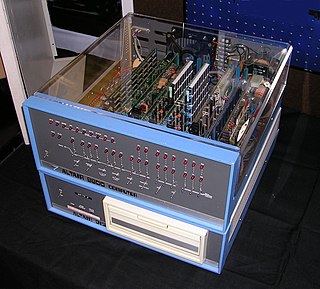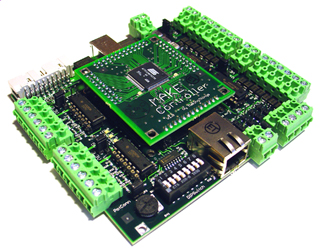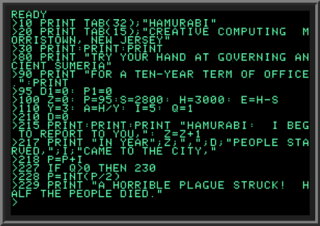
The Apple II is a personal computer released by Apple Inc. in June 1977. It was one of the first successful mass-produced microcomputer products and is widely regarded as one of the most important personal computers of all time due to its role in popularizing home computing and influencing later software development.

The MOS Technology 6502 is an 8-bit microprocessor that was designed by a small team led by Chuck Peddle for MOS Technology. The design team had formerly worked at Motorola on the Motorola 6800 project; the 6502 is essentially a simplified, less expensive and faster version of that design.

The 6800 is an 8-bit microprocessor designed and first manufactured by Motorola in 1974. The MC6800 microprocessor was part of the M6800 Microcomputer System that also included serial and parallel interface ICs, RAM, ROM and other support chips. A significant design feature was that the M6800 family of ICs required only a single five-volt power supply at a time when most other microprocessors required three voltages. The M6800 Microcomputer System was announced in March 1974 and was in full production by the end of that year.
In computer architecture, 8-bit integers or other data units are those that are 8 bits wide. Also, 8-bit central processing unit (CPU) and arithmetic logic unit (ALU) architectures are those that are based on registers or data buses of that size. Memory addresses for 8-bit CPUs are generally larger than 8-bit, usually 16-bit. 8-bit microcomputers are microcomputers that use 8-bit microprocessors.

A microcomputer is a small, relatively inexpensive computer having a central processing unit (CPU) made out of a microprocessor. The computer also includes memory and input/output (I/O) circuitry together mounted on a printed circuit board (PCB). Microcomputers became popular in the 1970s and 1980s with the advent of increasingly powerful microprocessors. The predecessors to these computers, mainframes and minicomputers, were comparatively much larger and more expensive. Many microcomputers are also personal computers. An early use of the term "personal computer" in 1962 predates microprocessor-based designs. (See "Personal Computer: Computers at Companies" reference below). A "microcomputer" used as an embedded control system may have no human-readable input and output devices. "Personal computer" may be used generically or may denote an IBM PC compatible machine.
Tiny BASIC is a family of dialects of the BASIC programming language that can fit into 4 or fewer KBs of memory. Tiny BASIC was designed by Dennis Allison and the People's Computer Company (PCC) in response to the open letter published by Bill Gates complaining about users pirating Altair BASIC, which sold for $150. Tiny BASIC was intended to be a completely free version of BASIC that would run on the same early microcomputers.

The KIM-1, short for Keyboard Input Monitor, is a small 6502-based single-board computer developed and produced by MOS Technology, Inc. and launched in 1976. It was very successful in that period, due to its low price and easy-access expandability.

The Altair 8800 is a microcomputer designed in 1974 by MITS and based on the Intel 8080 CPU. Interest grew quickly after it was featured on the cover of the January 1975 issue of Popular Electronics and was sold by mail order through advertisements there, in Radio-Electronics, and in other hobbyist magazines. According to Harry Garland, the Altair 8800 was the product that catalyzed the microcomputer revolution of the 1970s. It was the first commercially successful personal computer. The computer bus designed for the Altair was to become a de facto standard in the form of the S-100 bus, and the first programming language for the machine was Microsoft's founding product, Altair BASIC.

Southwest Technical Products Corporation, or SWTPC, was an American producer of electronic kits, and later complete computer systems. It was incorporated in 1967 in San Antonio, Texas, succeeding the Daniel E. Meyer Company. In 1990, SWTPC became Point Systems, before ceasing a few years later.
"An Open Letter to Hobbyists" is a 1976 open letter written by Bill Gates, the co-founder of Microsoft, to early personal computer hobbyists, in which Gates expresses dismay at the rampant software piracy taking place in the hobbyist community, particularly with regard to his company's software.

A custom built or home-built computer is a computer assembled by its user and made of commercial off-the-shelf (COTS) components, rather than purchased as a complete and ready to use machine, also known as a "pre-built" or out-of-the-box system.

The Apple II Plus is the second model of the Apple II series of personal computers produced by Apple Computer. It was sold from June 1979 to December 1982. Approximately 380,000 II Pluses were sold during its four years in production before being replaced by the Apple IIe in January 1983.

A microprocessor development board is a printed circuit board containing a microprocessor and the minimal support logic needed for an electronic engineer or any person who wants to become acquainted with the microprocessor on the board and to learn to program it. It also served users of the microprocessor as a method to prototype applications in products.

The history of the personal computer as a mass-market consumer electronic device began with the microcomputer revolution of the 1970s. A personal computer is one intended for interactive individual use, as opposed to a mainframe computer where the end user's requests are filtered through operating staff, or a time-sharing system in which one large processor is shared by many individuals. After the development of the microprocessor, individual personal computers were low enough in cost that they eventually became affordable consumer goods. Early personal computers – generally called microcomputers – were sold often in electronic kit form and in limited numbers, and were of interest mostly to hobbyists and technicians.

The CP1600 is a 16-bit microprocessor created in a partnership between General Instrument and Honeywell, introduced in February 1975. It is one of the first single-chip 16-bit processors. The overall design bears a strong resemblance to the PDP-11.
The MPT8080 "Microtutor" is a microprocessor trainer based on the Intel 8080 processor, developed by Limrose Electronics. It was designed in the mid-1970s to assist in the understanding of the then-new microprocessors.

A single-board microcontroller is a microcontroller built onto a single printed circuit board. This board provides all of the circuitry necessary for a useful control task: a microprocessor, I/O circuits, a clock generator, RAM, stored program memory and any necessary support ICs. The intention is that the board is immediately useful to an application developer, without requiring them to spend time and effort to develop controller hardware.

A BASIC interpreter is an interpreter that enables users to enter and run programs in the BASIC language and was, for the first part of the microcomputer era, the default application that computers would launch. Users were expected to use the BASIC interpreter to type in programs or to load programs from storage.
Smoke Signal Broadcasting, Inc. (SSB), later known as Smoke Signal, was an American computer company founded in 1976 by Frederic Jerome "Ric" Hammond of Hollywood, California. The company earned its reputation by offering expansions for the Southwest Technical Products (SWTPC) 6800 microcomputer. It later manufactured its own line of computers, called the Chieftain. Though it remains little-known, Smoke Signal was an early and important manufacturer of multi-user computer systems.
















